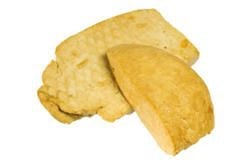Traditional & Protected Slovak Specialities
Fourteen. Yes, exactly 14 Slovakian products have won the protection of geographical indication for a product registered by the European Commission so far. We hope to see more of them in order to get this valuable label soon, because Slovakia has many more traditional and high quality products to offer!
SKALICKÝ TRDELNÍK
Skalický trdelník is a fine bakery product of hollow cylindrical shape with an internal diameter of 3-5 cm (1.18 to 1.97 in) and and external diameter of 6-10 cm (2.36 to 3.94 in). It is traditionally produced by winding a soft dough, which has first been allowed to rise, onto a roller called 'trdlo'.
After being wound onto the roller, the dough is coated with beaten egg whites and sprinkled with chopped walnuts or almonds or apricot kernels, or a mixture of these. It is then baked by radiant heat until golden and, after baking, is sprinkled with caster sugar mixed with vanilla sugar. (Photo: dinersclub.sk)
SLOVENSKÁ BRYNDZA
Slovenská bryndza is a natural, white, mature, spreadable cheese in granular form, manufactured according to the traditional method, by milling a lump of matured sheep's cheese or by milling a mixture of lump sheep's cheese and lump cow's cheese. The percentage of lump sheep's cheese is greater than 50%. It has a delicate odour and taste and has a pleasantly sour sheep's cheese taste that is slightly spicy and salty.
Slovenská bryndza is also used by the prepratation of a Slovak national meal called 'bryndzové halušky' - potato dumplings with bryndza. (Photo: izemplin.sk)
SLOVENSKÁ PARENICA
Slovenská parenica is a steamed, lightly smoked cheese wound into two rolls 6-8 cm (2.36 to 3.15 in) in diameter and 5-8 cm (1.97 to 3.15 in) high, connected in an 'S'-shape. The rolls are bound with cheese string or chain. Prior to being rolled up, the cheese strip is 2-3 mm (0.08 to 0.12 in) thick, 5-8 cm (1.97 to 3.15 in) wide and 4-6 m (4.37 to 6.56 yd) long.
Slovenská parenica has a delicate taste, the odour of sheep's milk and a smoky smell. It is known for the characteristically pronounced fibrous structure of the curd. It contains a minimum 53% dry matter and 50% fat in dry matter. (Photo: zlacnene.sk)
SLOVENSKÝ OŠTIEPOK
Slovenský oštiepok is a half-fat semi-hard cheese, which may be steamed or unsteamed and smoked or unsmoked. The basic raw material used to produce Slovenský oštiepok is sheep's milk, a mixture of sheep's and cow's milk or cow's milk. Slovenský oštiepok is produced either directly at a salaš (small-scale mountainside sheep farm), using the traditional on-farm method of production, or at dairies, using the industrial method.
Slovenský oštiepok is characterised by its special shape, that of a large egg, pine cone or ellipsoid with decoration. (Photo: pravda.sk)
OVČÍ SALAŠNÍCKY ÚDENÝ SYR
Ovčí salašnícky údený syr is produced from fresh sheep's milk, processed in shepherd's huts, smoked and often formed into specific shapes (hearts, cockerels or other animals, hemispheres).
The specific character is determined by the nature of the raw materials, i.e. raw sheep's milk, the traditional method of processing in shepherd's huts and by smoking. The term 'salašnícky' in the name expresses the product's specific nature and is derived from the word 'salaš', denoting a shepherd's hut, where the cheese is made, and hence also expresses a link to the place of production. (Photo: dinersclub.sk)
BRATISLAVSKÝ ROŽOK / PRESSBURGER KIPFEL / POZSONYI KIFLI
Bratislavský rožok is a fine, crescent-shaped pastry with a poppy-seed or walnut filling and a glossy and marbled surface, horseshoe shaped with narrower diameter for the poppy-seed filling, and a letter C shape for the walnut filling.
The Slovak name 'Bratislavský rožok' began to be used in about 1920, after the city of Pressburg, then part of Czechoslovakia and the capital of Slovakia, had been renamed Bratislava. As of that year, the name of the pastry was adapted in line with the city's new name, hence 'Bratislavský rožok'. After the new name of the city was adopted, the expression Kipfel began to be used in Austria, instead of the usual Beugel, together with the old name of the city. This custom has persisted in Austria to the present day, therefore the name 'Pressburger Kipfel' as the German version. The name originally used in Hungarian was Pozsonyi patkó (which translated as 'Bratislava horseshoe').
This product is still manufactured and marketed by several Hungarian bakers or confectioners under the name 'Pozsonyi kifli', which translates as 'Bratislavský rožok', the name of the city being in use from 1918. (Photo: ohlas.sk)
OVČÍ HRUDKOVÝ SYR - SALAŠNÍCKY
Ovčí hrudkový syr - salašnícky is a cheese with spherical shape, in the form of a lump, which is produced from fresh sheep's milk in shepherd's huts and derives its characteristic taste as a result of the traditional technology used during its fermentation, and of being shaped by hand into a lump.
The specific character is determined by the nature of the raw materials, i.e. raw sheep's milk and the traditional processing thereof in shepherd's huts. The term 'salašnícky' in the name expresses the product's specific nature and is derived from the word 'salaš', denoting a shepherd's hut, where the cheese is made, and hence also expresses a link to the place of production. (Photo: sme.sk)
ŠPEKAČKY
Špekačky are a heat-processed meat product made from a continuous strand several metres long stuffed into casing made of pork small intestine of beef rounds, and are golden-brown in colour. The name 'Špekačky' expresses the specific character of the agricultural product or foodstuff, which derives from the unevenly distributed pieces of bacon in a coarse mixture with a smallish proportion of collagen particles.
Špekačky are continuous strand, divided off with string into individual segments weighing 65 to 85 g (2.29 to 3 oz), about 4.0 to 4.6 cm (1.57 to 1.81 in) in diameter and 8 to 9 cm (3.15 to 3.54 in) in length. (Photo: lidovky.cz)
SPIŠSKÉ PÁRKY
The name 'Spišské párky' is specific in itself because it is well-established and well-known in Slovakia, has a long tradition, good reputation and relates to 'párky' of a particular type.
Spišské párky are contained in sheep-intestine casings of up to 24 mm (0.94 in) in diameter, continuous string, several metres long and are separated by twisting. The individual sausages weigh about 50 g (1.76 oz). They are typically pinkish-red in colour, owing to the paprika seasoning, and have a slightly piquant taste. (Photo: masoparizek.sk)
LOVECKÁ SALÁMA
The name 'Lovecká saláma' is specific in itself because it is well known in Slovakia and has a long, traditional association with a specific long-keeping fermented meat product having a characteristic flat rectangular block shape and a characteristic taste.
Lovecká saláma is a long-keeping fermented meat product intended for direct consumption, usually as a cold cut. The product characteristically has the shape of a flat rectangular block with a gut casing having an average diameter of 50-55 mm (1.97-2.17 in) and a length of around 40 cm (15.75 in). (Photo: zlacnene.sk)
LIPTOVSKÁ SALÁMA
The name 'Liptovská saláma' is specific in itself because it relates to a particular type of salami. In Slovakia it is well established and well known, and has a long tradition as well as a good reputation. Its manufacture has long conformed to national standards.
The characteristic features of Liptovská saláma are its homogeneous appearance when cut, its delicate meaty taste and the aroma imparted by the spices used and the smoking process. The shape of the product is cylindrical, 8-9 cm (3.15-3.54 in) in diameter, approximately 35-50 cm (13.78-19.69 in) in length; the mini product is approximately 5 cm (1.97 in) in diameter and 15-20 cm (5.9-7.87 in) in length. Both products are elastic to the touch. (Photo: poziadavka.sk)
ORAVSKÝ KORBÁČIK
Oravský korbáčik is a steamed cheese product, smoked or unsmoked, in the shape of a little whip (korbáčik in Slovak) between 10 and 50 cm (3.94 and 19.69 in) long. It is made using a traditional method, whereby fermented, partially ripened lump cheese is steamed in hot water and then stretched into string-like strands, traditionally known as vojky, between 2 and 10 mm (0.08 and 0.39 in) thick. The strands are then plaited together into the shape of a little whip.
The characteristic organoleptic properties of the cheese are imparted by the stringy texture of the strands pulled from the steamed cheese and by the special whip shape formed by plaiting the individual strands. Smoked and unsmoked Oravský korbáčik differ from each other mainly in colour and odour. Smoked Oravský korbáčik is slightly yellow to golden yellow and has a characteristic smoky aroma and a slightly (1%) higher salt content. Unsmoked Oravský korbáčik is white to creamy white, without a smoky aroma. The texture and consistency of both varieties are identical.
Oravský korbáčik is sold in multipacks wrapped food-quality film which vary according to how many korbáčiky they contain and the weight of the packaging. (Photo: zlacnene.sk)
TEKOVSKÝ SALÁMOVÝ SYR
Tekovský salámový syr is a natural semi-hard, ripened full-fat cheese, smoked or unsmoked, in the shape of a cylinder 30-32 cm (11.81-12.6 in) long, with a diameter of 9-9.5 cm (3.54-3.74 in). It is produced by curdling heat-treated milk and then forming the curd into the traditional cylindrical shape. After pressing, the cylinders are separated, processed and checked by hand. The smoked variety undergoes the smoking process after salting and drying.
The cheese gets its characteristic organoleptic properties from the cylinder shape itself, which is reminiscent of a salami and gives it its common name; the cheese has a soft, pliable and elastic structure, free of holes or with smallish holes apparent when cut. The relatively short ripening time gives the cheese its mildy acidulous characteristic dairy taste.
Tekovský salámový syr is placed on the market in food-quality film, the packaged weight of the individual cheeses varying slightly. (Photo: zlacnene.sk)
ZÁZRIVSKÝ KORBÁČIK
Zázrivský korbáčik is a steamed cheese product, smoked or unsmoked, in the shape of a little whip (korbáčik in Slovak) between 10 and 50 cm (3.94 and 19.69 in) long. It is made using a traditional method, whereby fermented, partially ripened lump cheese is steamed in hot water and then stretched into string-like strands, traditionally known as vojky, between 2 and 10 mm (0.08 and 0.39 in) thick. The strands are then plaited together into the shape of a little whip.
The characteristic organoleptic properties of the cheese are imparted by the stringy texture of the strands pulled from the steamed cheese and by the special whip shape formed by plaiting the individual strands. Smoked and unsmoked Zázrivský korbáčik differ from each other mainly in colour and odour. Smoked Zázrivský korbáčik is slightly yellow to golden yellow and has a characteristic smoky aroma and a slightly (1%) higher salt content. Unsmoked Zázrivský korbáčik is white to creamy white, without a smoky aroma. The texture and consistency of both varieties are identical.
Zázrivský korbáčik is sold in multipacks wrapped food-quality film which vary according to how many korbáčiky they contain and the weight of the packaging. (Photo: oravafoto.com)












